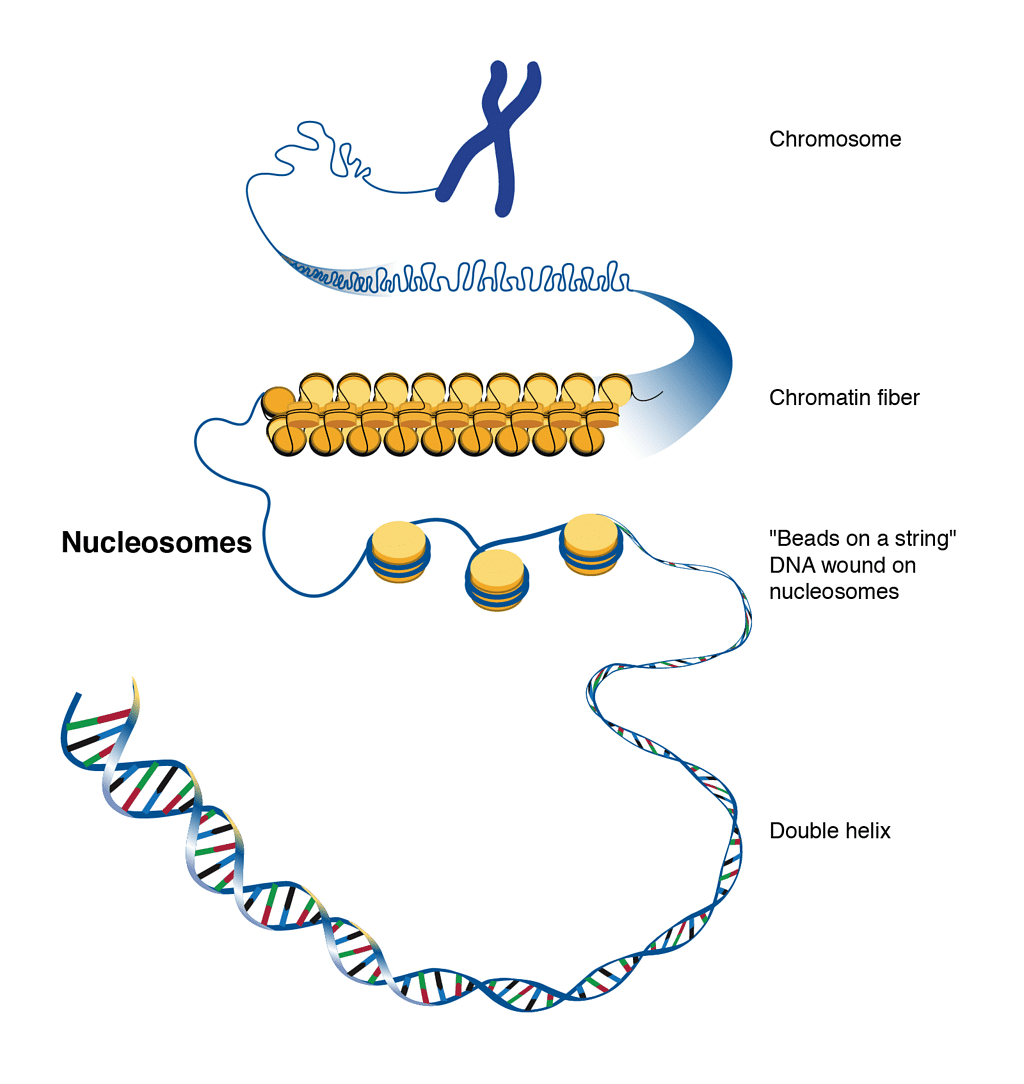Structure & Packaging of DNA Helix | Biology for Grade 12 PDF Download
Structure of DNA Double Helix
- DNA is a long polymer of deoxyribonucleotides. It is made up of two polynucleotide chains, where the backbone is constituted by sugar-phosphate and the bases project inside.
- The two chains have anti-parallel polarity, i.e. 5′ > 3′ for one, 3′ > 5′ for another.
 Fig: Double Helix Structure of DNA
Fig: Double Helix Structure of DNA - The bases in two strands are paired through hydrogen bond (H—bonds) forming base pairs (bp). Adenine forms two hydrogen bonds with thymine from the opposite strand and vice-versa. Guanine bonds with cytosine by three H—bonds. Due to this, purine always comes opposite to pyrimidine. This forms a uniform distance between the two strands.
- The two chains are coiled in a right-handed fashion. The pitch of the helix is 3.4 nm and there is roughly 10 bp in each turn. Due to this, the distance between a base pair in a helix is about 0.34 nm.
- The plane of one base pair stacks over the other in a double helix. This confers stability to the helical structure in addition to H—bonds.
The length of a DNA double helix is about 2.2 meters (6.6 x 109 bp x 0.34 x 10-9 m/bp)
Therefore, it needs special packaging in a cell.
Packaging of DNA Helix
DNA packaging is the process of tightly packing up the DNA molecule to fit into the nucleus of a cell.
Have you ever wondered how DNA is present in a nucleus smaller than it?
The DNA is an organic, complex, molecular structure, found in both prokaryotic and eukaryotic cells and also in many viruses. It is a hereditary material that is found in the nucleus of the cell and is mainly involved in carrying genetic information.
The DNA structure has the following characteristics:
- The strands of the DNA are helically wounded, every single strand forms a right-handed coil.
- The pitch of each helix is 3.32 nm and about 10 nucleotides make up one turn.
- The distance between two succeeding base pairs is 0.34 nm
- The total length of a DNA is the distance between two succeeding base pairs and the product of a total number of base pairs.
- A typical DNA has an extent around 2.2 meters, which is much longer than a nucleus.
- Prokaryotic cells can be distinguished from eukaryotic cells by the presence of a well-defined nucleus. However, their negatively charged DNA is arranged in a region called the nucleoid. They appear as a loop wrapped around a protein molecule having a positive charge.
- All eukaryotes have a well-defined nucleus that contains DNA. DNA is a negatively charged polymer, packed compactly within the chromatin engirdling the histone proteins, a ball of positively charged proteins.
- The octamer of histone proteins is wrapped with a DNA helix, giving rise to a structure called a nucleosome. The nucleosomes are further coiled which results in the formation of chromatin fibres. Chromatin fibres are stained thread-like structures whereas nucleosomes are beads present over it. These chromatin fibres condense to form chromosomes during mitosis.

Histones
Histones are the proteins promoting the DNA packaging into chromatin fibres. Histone proteins are positively charged possessing several arginine and lysine amino acids binding to the negatively charged DNA.

There are two types of Histones:
- Core Histones
- Linker Histones
- H2A, H2B, H3 and H4 are the core histones. Two H3, H4 dimers and two H2A, H2B dimers form an octamer.
- Linker histones lock the DNA in place onto the nucleosome and can be removed for transcription.
- Histones can be modified to change the amount of packaging a DNA does. The addition of the methyl group increases the hydrophobicity of histones. This results in tight DNA packaging.
- Acetylation and phosphorylation make the DNA more negatively charged and loosens the DNA packaging.
- Enzymes that add methyl groups to histones are called histone methyltransferases. The enzymes that add acetyl groups to the histones are called histone acetyltransferases while the ones that remove the histones are called histone deacetylases.
- The packaging of chromatin at higher level requires additional set of proteins which are collectively called Non-Histone Chromosomal (NHC) proteins.
- In a nucleus, some regions of chromatin are loosely packed (stains light) called euchromatin (transcriptionally active chromatin). In some regions, chromatin is densely packed (stains dark) called heterochromatin (inactive chromatin).
|
122 videos|161 docs|138 tests
|
FAQs on Structure & Packaging of DNA Helix - Biology for Grade 12
| 1. How is the structure of DNA double helix formed? |  |
| 2. What is the role of histones in the packaging of DNA? |  |
| 3. How does the packaging of DNA helix impact gene expression? |  |
| 4. What are the different levels of DNA packaging beyond nucleosomes? |  |
| 5. How does the packaging of DNA helix impact DNA replication and repair processes? |  |

|
Explore Courses for Grade 12 exam
|

|















